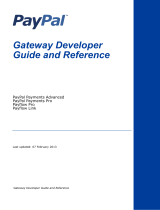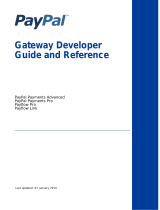
Payflow Pro – HTTPS
Interface Developer’s
Guide
For Professional Use Only
Currently only available in English.
A usage Professional Uniquement
Disponible en Anglais uniquement pour l’instant.
Last updated: May 2009

Payflow Pro – HTTPS Interface Developer’s Guide
Document Number: 200038.en_US-200905
© 2009 PayPal, Inc. All rights reserved. PayPal is a registered trademark of PayPal, Inc. The PayPal logo is a trademark of PayPal, Inc. Other
trademarks and brands are the property of their respective owners.
The information in this document belongs to PayPal, Inc. It may not be used, reproduced or disclosed without the written approval of PayPal, Inc.
Copyright © PayPal. All rights reserved. PayPal (Europe) S.à r.l. et Cie., S.C.A., Société en Commandite par Actions. Registered office: 22-24 Boulevard
Royal, L-2449, Luxembourg, R.C.S. Luxembourg B 118 349.
Consumer advisory: The PayPal™ payment service is regarded as a stored value facility under Singapore law. As such, it does not require the approval
of the Monetary Authority of Singapore. You are advised to read the terms and conditions carefully.
Notice of non-liability:
PayPal, Inc. is providing the information in this document to you “AS-IS” with all faults. PayPal, Inc. makes no warranties of any kind (whether express,
implied or statutory) with respect to the information contained herein. PayPal, Inc. assumes no liability for damages (whether direct or indirect), caused
by errors or omissions, or resulting from the use of this document or the information contained in this document or resulting from the application or use
of the product or service described herein. PayPal, Inc. reserves the right to make changes to any information herein without further notice.

HTTPS Interface Developer’s Guide April 2009 3
Contents
Preface . . . . . . . . . . . . . . . . . . . . . . . . . . . . . . . . . . 5
This Document . . . . . . . . . . . . . . . . . . . . . . . . . . . . . . . . . . . . . . . . . 5
Revision History . . . . . . . . . . . . . . . . . . . . . . . . . . . . . . . . . . . . . . . . 5
Chapter 1 About the HTTPS Interface . . . . . . . . . . . . . . . . . 7
Overview . . . . . . . . . . . . . . . . . . . . . . . . . . . . . . . . . . . . . . . . . . . . 7
Moving from the Payflow SDK to the HTTPS interface . . . . . . . . . . . . . . . . . . . . 7
Getting sample code . . . . . . . . . . . . . . . . . . . . . . . . . . . . . . . . . . . . . . 8
Contacting Support. . . . . . . . . . . . . . . . . . . . . . . . . . . . . . . . . . . . . . . 8
Chapter 2 Reference . . . . . . . . . . . . . . . . . . . . . . . . . . 9
URLs for sending messages . . . . . . . . . . . . . . . . . . . . . . . . . . . . . . . . . . 9
HTTPS headers . . . . . . . . . . . . . . . . . . . . . . . . . . . . . . . . . . . . . . . . 9
Transaction message . . . . . . . . . . . . . . . . . . . . . . . . . . . . . . . . . . . . 11
Common problems . . . . . . . . . . . . . . . . . . . . . . . . . . . . . . . . . . . . . . 13

Contents
4 April 2009 HTTPS Interface Developer’s Guide

HTTPS Interface Developer’s Guide April 2009 5
Preface
This Document
This document describes the HTTPS interface, which allows you to post transactions directly
to the Payflow servers. Use the HTTPS interface for all operating systems and language
besides Java and .NET.
Revision History
Date Description
April 2009 Minor updates for technical accuracy.
February 2008 Updated test and live URLs.
December 2007 Clarification that the related SDKs referred to in this guide are Payflow, not
PayPal, SDKs.
Update of test and live URLs.
Remove Client Certification ID header.
Reference to Developer’s Guide for more information on transaction result
values.
August 2007 First version of this document.

Revision History
6 April 2009 HTTPS Interface Developer’s Guide

HTTPS Interface Developer’s Guide April 2009 7
1
About the HTTPS Interface
This chapter contains the following topics:
z Overview
z Moving From the Payflow SDK to the HTTPS Interface
z Getting Sample Code
z Contacting Support
Overview
The HTTPS interface allows you to post transactions directly to the Payflow servers.
N OTE: If you are programming in Java or .NET, you can simplify the implementation by using
a Payflow SDK. The Payflow SDKs are based upon this HTTPS interface. Payflow
SDK, Version 4 or later for .NET, can be used with classic ASP. For information on the
Payflow SDKs, go to Developer Central at the URL below and click the SDK and
Downloads link on the Library tab.
http://www.paypal.com/developer
This guide contains the information you will need to construct the HTTPS message. The body
of the transaction is in name-value pair (NVP) or XMLPay format. For details on the NVP
format, see the appropriate guide:
z Payflow Pro Developer’s Guide
z Website Payments Pro Payflow Edition Developer’s’ Guide
For details on XMLPay format, see the appropriate XMLPay guide:
z Payflow Pro XMLPay Developer’s Guide
z Website Payments Pro Payflow Edition - XMLPay Developer’s’ Guide
Moving From the Payflow SDK to the HTTPS Interface
The Payflow SDK, Version 3 or earlier, contains APIs that do the following:
1. Create a connection with the Payflow server
2. Submit the transaction
3. Destroy the transaction

About the HTTPS Interface
Getting Sample Code
8 April 2009 HTTPS Interface Developer’s Guide
When you move to the HTTPS interface, you will have to rewrite these portions of the code.
You will need to complete four steps:
1. Write code that creates an HTTPS connection with the Payflow server.
2. Write an HTTPS request to submit your transaction data.
3. Receive the HTTPS reponse and extract the parameters.
4. Add code for error handling, retry logic, and duplicate transaction handling.
Getting Sample Code
For sample code, visit the Payflow Gateway forum in the PayPal Developer Community.
Contacting Support
For support, post your question or issue on the Payflow Gateway forum or open a ticket on the
Contact Support tab at
https://www.paypal.com/mts.

HTTPS Interface Developer’s Guide April 2009 9
2
Reference
This chapter contains the following topics:
z URLs for Sending Messages
z Standard HTTPS Headers
z Transaction Message
z Common Problems
URLs for Sending Messages
Use the following URLs for sending transactions to PayPal's Payflow servers:
z Production (Live): https://payflowpro.paypal.com
z Pilot (Test): https://pilot-payflowpro.paypal.com
HTTPS Headers
Standard HTTPS Headers
HTTPS Header Description Req?
Connect State of the connection. The server returns the value close to
close the connection after the response is sent.
No
Content-Length Size of message body. Yes
Content-Type Provide one of the following values:
z text/namevalue: transaction request body is in NVP
format.
z text/xml: transaction request body is in XMLPay 2.0
format.
Yes
Host Provide one of the two host URLs:
z Production: payflowpro.paypal.com
z Pilot (test): pilot-payflowpro.paypal.com
Yes

Reference
HTTPS Headers
10 April 2009 HTTPS Interface Developer’s Guide
PayPal Protocol Headers
Protocol Header Description Req?
X-VPS-REQUEST-ID A unique identifier for each request, whether the request is a
single NVP transaction or an XMLPay 2.0 document with
multiple transactions. This identifier is associated with all the
transactions in a particular request.
You must provide the X-VPS-REQUEST-ID value in the
transaction request. The Payflow server uses the X-VPS-
REQUEST-ID to check for duplicate transaction requests. When a
transaction request is received, the server checks to see if the X-
VPS-REQUEST-ID has been used before by this merchant.
z If the X-VPS-REQUEST-ID has been used before, the server
views it as a retry transaction, and the transaction is treated as
a duplicate. The response to the original transaction is
returned to the merchant, but a name-value pair of
DUPLICATE=1 is added to indicate that this transaction is a
duplicate.
I MPORTANT: If you send new transaction data with a
previously used X-VPS-REQUEST-ID, the server
ignores the new data and returns the response to
the original transaction associated with that X-
VPS-REQUEST-ID.
In Manager, duplicate transactions are associated with the
TENDERTYPE N.
It is very important that you check transaction responses for
DUPLICATE=1. If the transaction is not a retry of an original
failed transaction request, you must change the Request ID.
z If the X-VPS-REQUEST-ID has not been used before, the
server stores the X-VPS-REQUEST-ID to ensure that the X-
VPS-REQUEST-ID is not reused and then runs the associated
transactions.
Duplicate checking is designed for short-term retries (a few
minutes to a few hours after the original transaction).
Although the X-VPS-REQUEST-ID is stored for a minimum
of
7 days, it is not recommended that you send a retry so
long after the original transaction.
Data type: 1 to 32 printable characters
Yes
X-VPS-CLIENT-
TIMEOUT
Time-out value in seconds. A transaction times out if the elapsed
time between ending the original transaction request and
receiving the transaction response exceeds the value of X-VPS-
CLIENT-TIMEOUT.
The recommended value is 45.
Yes

HTTPS Interface Developer’s Guide April 2009 11
Reference
Transaction Message
Integrator-Provided Headers
These headers are extensions to the Payflow HTTPS interface. The extension parameters
describe the version of the application and the application’s environment.
N OTE: Even though these parameters are not required, it is strongly recommended that you
send them.
Transaction Message
The transaction message communicates the initial transaction data to the server. It is made up
of the transaction request and response.
Parameter Description Req?
X-VPS-VIT-
INTEGRATION-PRODUCT
Identifies the product that is integrated with the Payflow
server.
Data type: string
Examples: iPayment, ColdFusion, MIVA, shopping
cart
Default: blank
No
X-VPS-VIT-
INTEGRATION-VERSION
Version of the software as defined by the integrator or
vendor. Limited to the major version and one digit of the
minor version.
Data type: alphanumeric string in the format:
<Major Version>.<Minor Version>
Examples: 1.1, 4.5, 10.0, Linux2.1
Default: blank
No
X-VPS-VIT-OS-NAME Name of operating system that the application is running
on.
Data type: string
Examples: Linux, SunOS, Windows 2000, Windows
NT, Windows XP, Mac OS X, Free BSD.
Default: blank
No
X-VPS-VIT-OS-
VERSION
Version of operating system that application is running on.
Data type: string in the format XXX.X
Example: 2.4
Default: blank
No
X-VPS-VIT-RUNTIME-
VERSION
Version of runtime environment of the language that the
application is running on.
Data type: string in the format XXX.X
Examples: 10.1, 2.5
Default: blank
No

Reference
Transaction Message
12 April 2009 HTTPS Interface Developer’s Guide
N OTE: The examples below are in NVP format. XMLPay uses the same format as NVP except
that the content-type is text/xml and the body of both the request and response
contain the XML document.
Transaction Request
The transaction request consists of a transaction request header and body.
Transaction Request Header
The following is an example of a transaction request header associated with a message in NVP
format:
Connect: close
Content-Length: ...
Content-Type: text/namevalue
Host: payflowpro.paypal.com
X-VPS-REQUEST-ID: 9a5534f7e4f3a5e5138b062e000b279a
X-VPS-CLIENT-TIMEOUT: 45
X-VPS-VIT-CLIENT-CERTIFICATION-ID: 33baf5893fc2123d8b191d2d011b7fdc
X-VPS-VIT-Integration-Product: MyApplication
X-VPS-VIT-Integration-Version: 0.01
Transaction Request Body
The transaction request body contains the transaction information. The following is an
example of a transaction request body in NVP format:
TRXTYPE[1]=S&ACCT[16]=5105105105105100&EXPDATE[4]=0109&
TENDER[1]=C&INVNUM[8]=INV12345&AMT[5]=25.12&PONUM[7]=PO12345&
STREET[23]=123 Main St.&ZIP[5]=12345&USER[6]=jsmith&
VENDOR[6]=jsmith&PARTNER[8]=PayPal&PWD[8]=testing1
The bracketed numbers are length tags that allow you to use the special characters & and = in
the value sent. See the Payflow Pro Developer’s Guide for more information.
Transaction Response
The transaction response consists of a transaction response header and body.
Transaction Response Header
The following is an example of a transaction response header associated with a message in
NVP format:
Connect: close
Server: VPS-3.033.00
X-VPS-REQUEST-ID: 9a5534f7e4f3a5e5138b062e000b279a
Date: Mon, 16 May 2005 22:48:06 GMT
Content-Type: text/namevalue
Content-Length: 145
X-VPS-REQUEST-ID is the same ID sent in the transaction request.

HTTPS Interface Developer’s Guide April 2009 13
Reference
Common Problems
Transaction Response Body
The transaction response body contains the response to the request. The following is an
example response body in NVP format:
RESULT=0&PNREF=V53A0A30B542&RESPMSG=Approved&AUTHCODE=882PNI&
AVSADDR=X&AVSZIP=X&IAVS=X&PREFPSMSG=No Rules Triggered&
POSTFPSMSG=No Rules Triggered
Common Problems
N OTE: For additional information on transaction result values, see the appropriate developer’s
guide: Payflow Pro Developer’s Guide or Website Payments Pro Payflow Edition
Developer’s Guide.
Problem Description
Result value 1 User authentication error. Can be caused by:
z Invalid login information or IP restrictions on the account. Verify that
there are no IP restrictions in PayPal Manager.
z Verify USER, VENDOR, PARTNER, and PASSWORD. Remember that
USER and VENDOR are both the merchant login ID unless a Payflow
USER was created. All field values are case-sensitive.
z Not appending /transaction to the host URL. This requirement
will be removed in the future.
Result value 26 Verify USER, VENDOR, PARTNER, and PASSWORD. Remember that USER
and VENDOR are both the merchant login ID unless a Payflow a was
created. All field values are case-sensitive.
No response received Usually caused by posting to an incorrect host URL.

Reference
Common Problems
14 April 2009 HTTPS Interface Developer’s Guide
-
 1
1
-
 2
2
-
 3
3
-
 4
4
-
 5
5
-
 6
6
-
 7
7
-
 8
8
-
 9
9
-
 10
10
-
 11
11
-
 12
12
-
 13
13
-
 14
14
PayPal Website Payments Pro - 2009 - HTTPS Interface User guide
- Type
- User guide
- This manual is also suitable for
Ask a question and I''ll find the answer in the document
Finding information in a document is now easier with AI
Related papers
-
PayPal Website Payments Pro - 2007 - HTTPS Interface User guide
-
PayPal Website Payments Pro 2009 User guide
-
 PayPal Gateway Gateway - 2013 User guide
PayPal Gateway Gateway - 2013 User guide
-
 PayPal Payflow Payflow 2009 User guide
PayPal Payflow Payflow 2009 User guide
-
 PayPal Payflow Payflow Pro 2007 User guide
PayPal Payflow Payflow Pro 2007 User guide
-
 PayPal Gateway Gateway 2014 User guide
PayPal Gateway Gateway 2014 User guide
-
 PayPal Payflow Payflow Pro 2009 User guide
PayPal Payflow Payflow Pro 2009 User guide
-
 PayPal Payflow Payflow Pro - 2008 User guide
PayPal Payflow Payflow Pro - 2008 User guide
-
 PayPal Payflow Payflow Pro 2008 User guide
PayPal Payflow Payflow Pro 2008 User guide
-
PayPal Website Payments Pro - 2007 User guide
Other documents
-
DataVideo NVP-20 User manual
-
Parallels H-Sphere 3.3 User guide
-
Parallels H-Sphere 3.2 User guide
-
 Caton NVP-990-R2 Reference guide
Caton NVP-990-R2 Reference guide
-
Parallels H-Sphere 3.1 User guide
-
Parallels H-Sphere 3.4 User guide
-
Parallels H-Sphere 3.4.1 User guide
-
Parallels H-Sphere 3.6 User guide
-
Parallels H-Sphere 3.5.1 User guide
-
Parallels H-Sphere 3.5 User guide





















